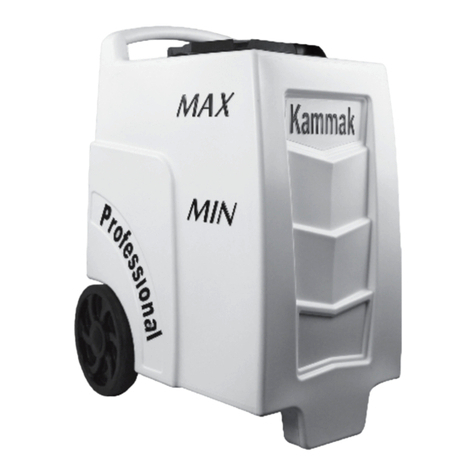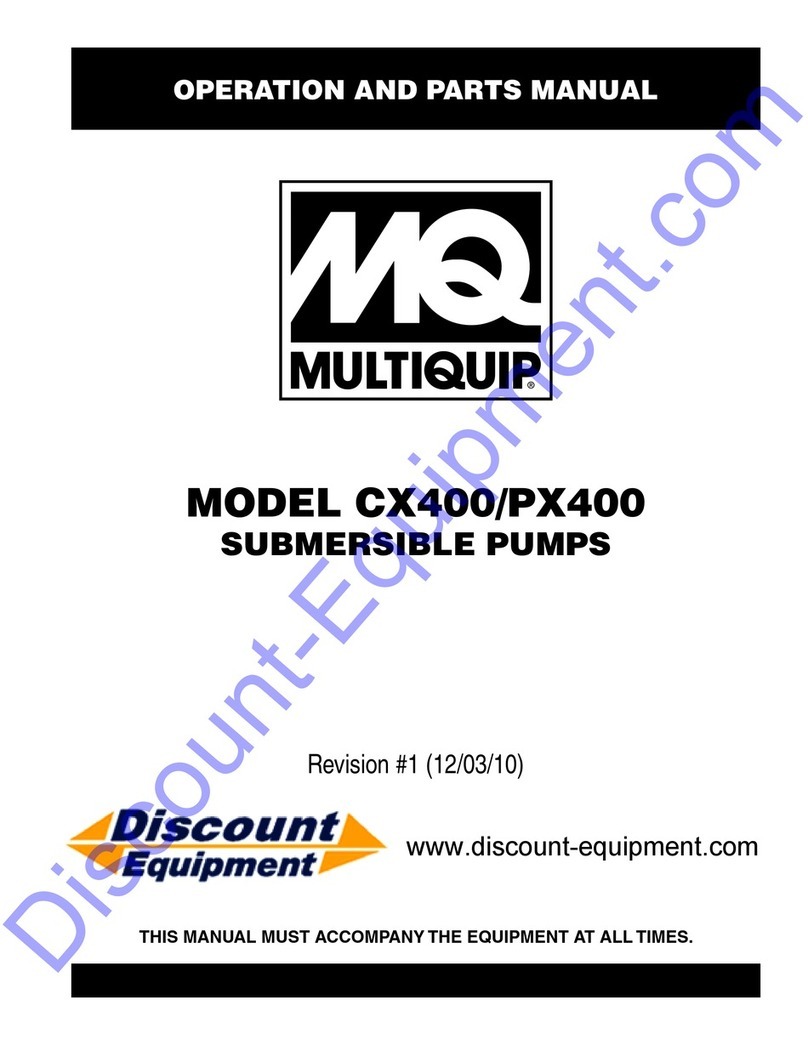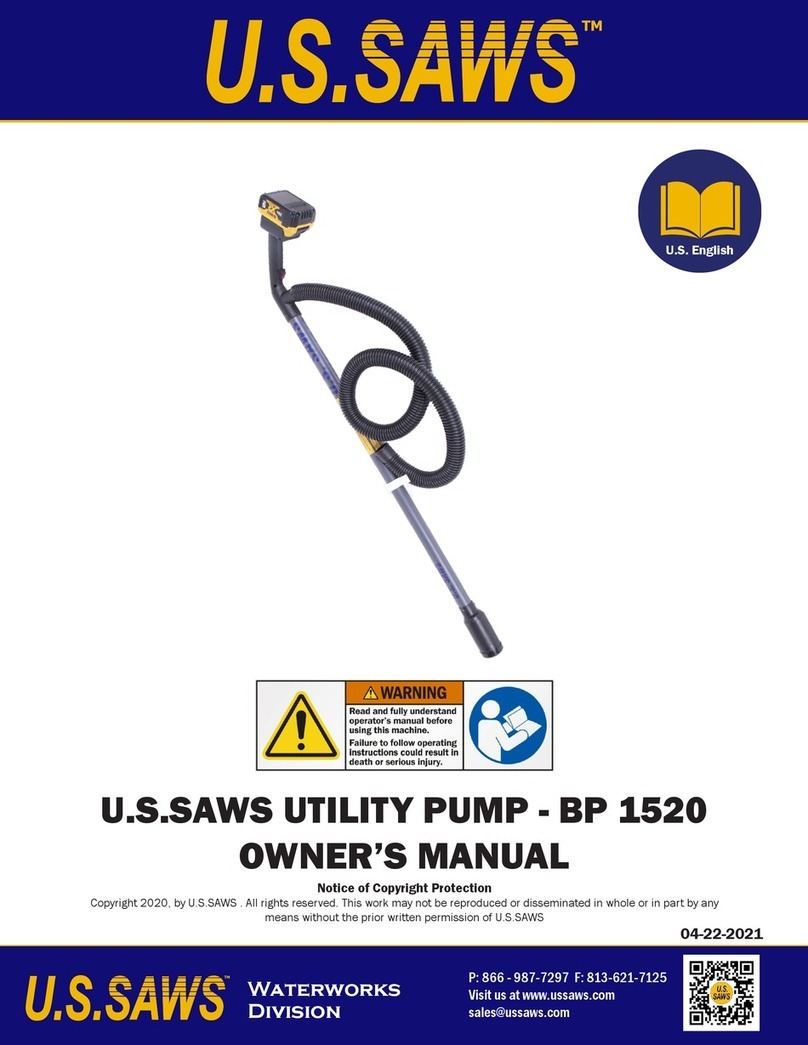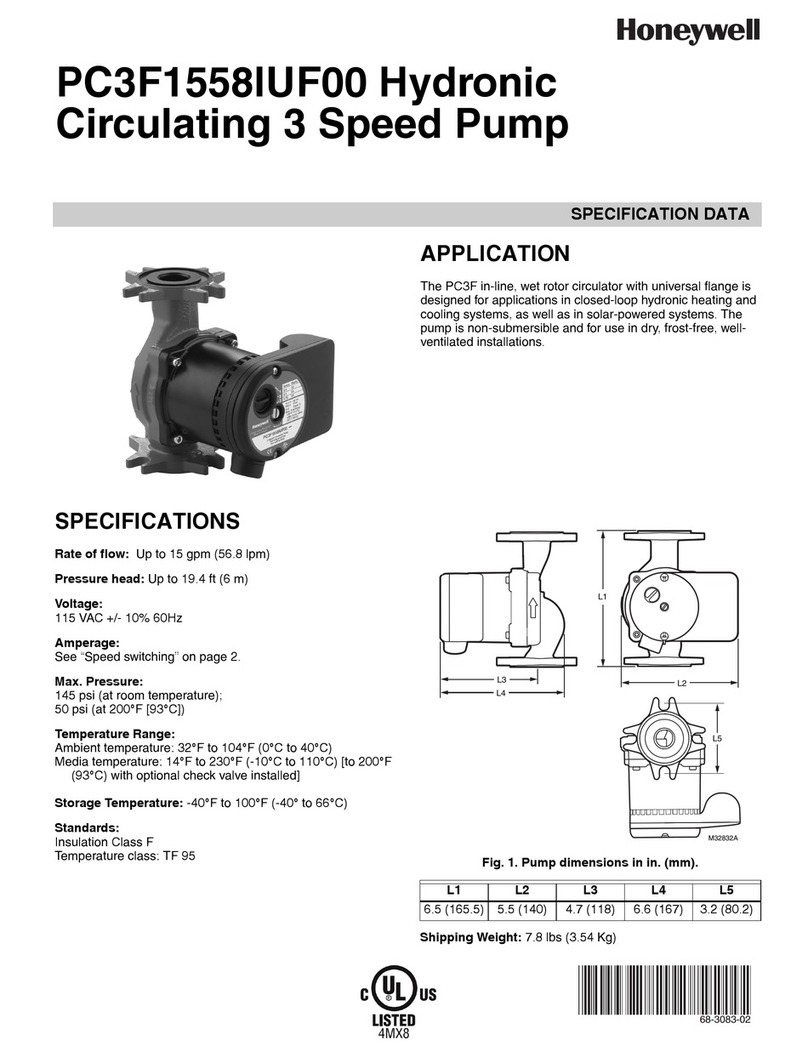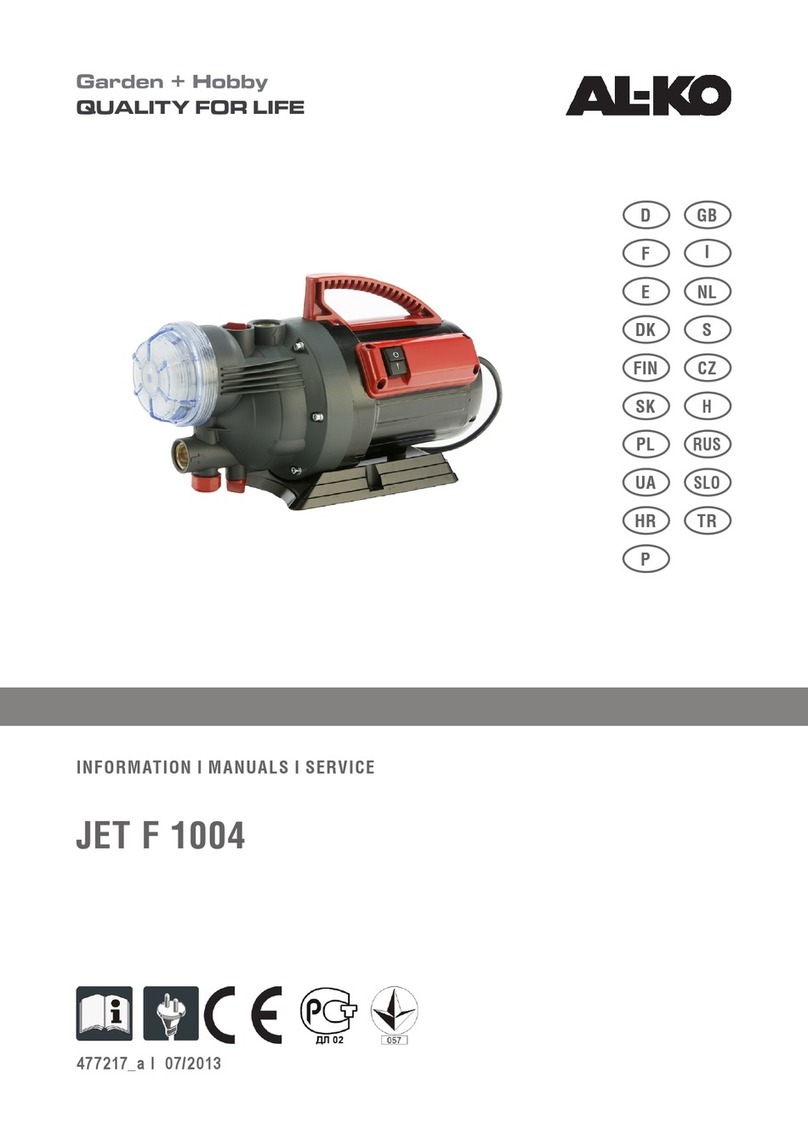Cattani TURBO-JET 1 modular manual

IMPIANTI MONOSTUDIO E
CENTRALIZZATI AD UMIDO
CON TURBO-JET modular
SEMI-WET SINGLE-SURGERY AND CENTRALIZED SYSTEMS WITH
TURBO-JET
modular
INSTALLATIONS MONOSTUDIO ET CENTRALISÉES À HUMIDE AVEC
TURBO-JET
modular
ZENTRAL UND FÜR EINEN BEHANDLUNGSTUHL
KOMBI-ABSAUGANLAGEN MIT TURBO-JET
modular
INSTALACIÓNES DE ASPIRACIÓN MONOESTUDIO Y CENTRALIZADOS
DE HÚMEDO CON TURBO-JET
modular
•MANUALE ISTRUZIONI
•INSTRUCTIONS HANDBOOK
•MANUEL D'INSTRUCTIONS
•GEBRAUCHSANWEISUNGEN
•MANUAL DE INSTRUCCIONES
CATTANI S.p.A.
Ed. NOV. 2002
©
11/02
ITALIAN PATENTS OR PATENT APPLICATIONS:
CATTANI: 1201707 - 1234828 - 1259318 - 1.187.187 - 1253460 - 233634 - 2337706 -1294904
ESAM: 1225173 - 1253783 - 0791751
FOREIGN PATENTS OR PATENT APPLICATIONS:
CATTANI: AU 546.143 - US 4,386,910 - US 4,787,846 - US 5,039,405 - US 5,002,486 - AU 580839 - US 4,684,345
US 5,330,641 - AT 0040181 - CH 0040181 - DE 0040181 - FR 0040181 - GB 0040181 - LU 0040181 - SE 0040181
CH 0211808 - DE 0211808 - FR 0211808 - GB 0211808 - SE 0211808 - DE 0335061 - ES 0335061 - FR 0335061
GB 0335061 - AT 0557251 - DE 0557251 - ES 0557251 - FR 0557251 - GB 0557251 - DE 0638295 - DK 0638295
ES 0638295 - FR 0638295 - GB 0638295 - NL 0638295 - SE 0638295 - US 6,083,306 - US 6,090,286 - US 6,022,216
ESAM: US 4,948,334 - DE 0351372 - ES 0351372 - FR 0351372 - GB 0351372 - EP 0791751 - US 5,779,443 - CH 0791751
DE 0791751 - ES 0791751 - FR 0791751 - GB 0791751 - PT 0791751 - AU 93321 - ES 107358 - FR 222.394/395
PENDING PATENT
CATTANI: IT M098A000019 - IT M098A000119 - EP 99830010.7 - EP 99830011.5 - EP 99830250.9 - EP 00830491.7
IT M099A000165 - US 09/624,182
CATTANI S.p.A.
VIA NATTA, 6/A - 43100 PARMA - ITALY
TEL: +39 0521 607604 - SALE DEPT. FAX: +39 0521 607628
PURCHASING DEPT. FAX: +39 0521 607855 - ACCOUNTING DEPT. FAX: +39 0521 399966
ESAM S.p.A.
VIA NATTA, 4/A - 43100 PARMA - ITALY
TEL: +39 0521 607613 - SALE DEPT. FAX: +39 0521 607628
PURCHASING DEPT. FAX: +39 0521 607855 - ACCOUNTING DEPT. FAX: +39 0521 399966
INDICE MANUALI
PRODOTTI
Products
Manual's Index

1
— DATI GENERALI DI FUNZIONAMENTO 50 Hz .............................................
—DATI GENERALI DI FUNZIONAMENTO 60 Hz .............................................
—INTRODUZIONE ...........................................................................................
—SEGNALI ED AVVISI .....................................................................................
—CARATTERISTICHE GENERALI ..................................................................
—CENTRALINI ELETTRICI E LOCALE TECNICO ..........................................
—RACCOMANDAZIONI E PREVENZIONE .................................................
—PROGETTAZIONE DELLE CANALIZZAZIONI ASPIRANTI .........................
—FUNZIONAMENTO .......................................................................................
—AVVERTENZE GENERALI E RISCHIO BIOLOGICO ...................................
—MANUTENZIONE RISERVATA AL PERSONALE DELLO STUDIO ..............
—MANUTENZIONI E CONTROLLI RISERVATI AI TECNICI AUTORIZZATI .....
—AVVISI IMPORTANTI .....................................................................................
—TRASPORTO E STOCCAGGIO ....................................................................
—TRASPORTO DI APPARECCHI USATI .........................................................
2
3
4
4
5
5
5
6
7
7
8
8
9
9
9
ITALIANO
Pagina
INDICE
IMPIANTI MONOSTUDIO
E CENTRALIZZATI
AD UMIDO CON TURBO-JET modular
HOME

2
Corrente alternata
Terra di protezione
Aperto (sconnessione dalla rete di alimentazione)
Chiuso (connessione dalla rete di alimentazione)
IEC 417-5032
IEC 417-5019
IEC 417-5008
IEC 417-5007
Grado di protezione contro i
contatti diretti o indiretti tipo
Protezione contro l'umidità
Modalità di impiego
Tipo di apparecchio
Classe di isolamento
Corrente nominale
Tensione nominale
Modello
Frequenza nominale
Potenza resa
Portata massima
Prevalenza massima per
il servizio continuo
Pressione sonora versione
scarenata**
Pressione sonora versione
carenata**
Pressione sonora versione
insonorizzata**
TURBO-TECNO
modular
TURBO-TECNO
modular
*TURBO-JET 1
modular
4 A
B
S1
comune
50 Hz
0,42 kW
650 l/min
1500
mm H
2
O
61 dB (A)
230 V
B
58 dB (A)
52 dB (A)
*TURBO-JET 2
modular
6,1 A
B
S1
comune
50 Hz
0,8 kW
650 l/min
65 dB (A)
230 V
B
61 dB (A)
56 dB (A)
2600
mm H
2
O
TURBO-TECNO
2V
modular
11,4 A
B
S1
comune
50 Hz
1,5 kW
1500 l/min
68 dB (A)
230 V
B
64 dB (A)
60 dB (A)
2600
mm H
2
O
8,1/4,7 A
B
S1
comune
50 Hz
1500 l/min
68 dB (A)
B
64 dB (A)
60 dB (A)
1,5 kW
2600
mm H
2
O
TURBO-FLUX
modular
TURBO-FLUX
modular
50 Hz 50 Hz 50 Hz 50 Hz
230 V230 V
8,3 A 12,3 A
BB BB
S1 S1 S1 S1
comune comune comune comune
BB B B
0,95 kW 0,95 kW 1,7 kW 1,7 kW
1400 l/min 1400 l/min 2100 l/min 2100 l/min
1750
mm H
2
O1750
mm H
2
O2000
mm H
2
O2000
mm H
2
O
64 dB (A) 64 dB (A) 65,5 dB (A) 65,5 dB (A)
60 dB (A) 60 dB (A) 63 dB (A) 63 dB (A)
—— ——
3
230/400 V
5,6/3,2 A 8,6/5 A
3
230/400 V
3
230/400 V
TURBO-TECNO
2V
modular
11,2/6,5A
B
S1
comune
50 Hz
2200 l/min
—
B
—
—
2,4 kW
2350
mm H
2
O
3
230/400 V
TURBO-FLUX
2V
modular
Dati generali di funzionamento 50 Hz
Aspiratore ad uso dentistico
HOME
INDICE

3
ITALIANO
Dati generali di funzionamento 60 Hz
Aspiratore ad uso dentistico
* Il motore èprotetto da una pastiglia termica.
L’apparecchio non puòfunzionare in presenza di una miscela anestetica infiam-
mabile con l’aria, o ossigeno, o protossido di azoto.
Possono essere richieste frequenze e tensioni diverse.
** Livello di pressione sonora rilevata secondo la norma ISO 3746-1979 (E).
Parametri: r=1 - Rumore di fondo 34 dB (A) - Strumento: Brüel & Kjær Type 2232.
Costruito dalla CATTANI S.p.A. - PARMA - ITALIA
TURBO-FLUX 2V
modular
3
265/460 V
60 Hz
11,2/6,5 A
B
S1
comune
B
2,85 kW
2600 l/min
2600
mm H
2
O
—
—
Grado di protezione contro i
contatti diretti o indiretti tipo
Protezione contro l'umidità
Modalitàdi impiego
Tipo di apparecchio
Classe di isolamento
Corrente nominale
Tensione nominale
Modello
Frequenza nominale
Potenza resa
Portata massima
Prevalenza massima per
il servizio continuo
Pressione sonora versione
scarenata**
Pressione sonora versione
carenata**
Pressione sonora versione
insonorizzata**
*TURBO-JET 1
modular
4,6 A
B
S1
comune
60 Hz
0,52 kW
750 l/min
1500
mm H
2
O
230 V
B
*TURBO-JET 2
modular
7,1 A
B
S1
comune
60 Hz
0,92 kW
900 l/min
230 V
B
2600
mm H
2
O
B
S1
comune
60 Hz
1600 l/min
B
TURBO-TECNO 2V
modular
1,75 kW
2800
mm H
2
O
3
220/380 V
60 Hz
10,4/6 A
B
S1
comune
B
2 kW
2350 l/min
2100
mm H
2
O
68,5 dB (A)
—
—
—
—
—
—
—
—
TURBO-TECNO
modular
60 Hz
11,7 A
B
S1
comune
B
1,15 kW
1600 l/min
2000
mm H
2
O
67 dB (A)
—
—
230 V
60 Hz
6,4/3,7 A
B
S1
comune
B
1,15 kW
1600 l/min
2000
mm H
2
O
67 dB (A)
—
—
3
220/380 V
3
220/380 V
9,9/5,7 A
—
—
—
TURBO-TECNO
modular
TURBO-FLUX
modular
—
HOME
INDICE

4
Introduzione
La presentazione che segue ha lo scopo di illustrare le attrezzature e gli impianti in
oggetto, di spiegarne il funzionamento, la manutenzione e di informare circa i pericoli e
le precauzioni utili alla prevenzione.
Per evitare qualsiasi malinteso ci sembra utile chiarire che cosa si intenda per: impianti
ad aria, a liquido e ad umido.
•Nell’impianto ad aria, il circuito aspirante èpercorso integralmente da aria, ed il
gruppo aspirante crea la depressione mediante un anello d’aria.
•Nell’impianto a liquido, il circuito aspirante èpercorso da un fluido composto
dal liquido aspirato e da aria, nella pompa l’anello risulta composto quasi
esclusivamente da liquido.
•Nel sistema ad umido si ha una situazione mista rispetto alle due precedenti: il circuito
aspirante èpercorso dal liquido aspirato e da aria (come nella versione a liquido) il
gruppo aspirante invece èad anello ad aria.
In breve:
•nella versione ad aria, circuito aspirante e pompa sono percorsi da aria;
•nella versione a liquido, circuito aspirante e pompa sono percorsi da liquido;
•in quella ad umido, il circuito aspirante èpercorso da liquido e la pompa è
percorsa da aria.
Segnali ed avvisi
Pericolo di scosse elettriche, anche la 230 V puòrisultare mortale.
Pericolo biologico, infezioni da malattie epidemiche.
Alta temperatura.
Segnale generico di pericolo.
Direzione obbligatoria del flusso o del senso di rotazione.
Non sempre èpossibile esprimere con un segnale gli avvisi di pericolo, èperciò
necessario che l’utilizzatore legga gli avvisi e li tenga in debito conto.
Non rispettare un segnale od un avviso di pericolo, puòcausare danno
all’operatore od al paziente.
Non rimuovere le protezioni antinfortunistiche, non modificare le macchine
od il loro funzionamento.
Nonostante il nostro impegno èpossibile che gli avvisi di pericolo non siano esaustivi,
chiediamo venia all’utilizzatore, pregandolo nel contempo di prevedere egli stesso le
fonti di pericolo che ci fossero sfuggite e darcene notizia.
HOME
INDICE

5
Caratteristiche generali
(fig. 2-3-5-6-6/A-6/B-
7/A-7/B
-8-9 pag. 51-52-53-54-55-56-57-58)
Mentre gli impianti ad aria sono particolarmente indicati per studi a prevalente attivitàprotesica,
viceversa, gli impianti a liquido sono piùadatti per studi ad indirizzo chirurgico, gli impianti ad
umido sono ugualmente consigliabili per entrambe le specialitàcitate.
Nato da una sintesi dei primi due, I’impianto ad umido èil piùrecente e forse (se l’esperienza
ne confermeràla validità) saràdestinato a sopravvivere ai primi. Nella serie piccoli impianti ad
umido sono in produzione: il gruppo Turbo-Jet 1 modular e Turbo-Jet 1 modular versione UK
consigliati per uno studio, Turbo-Jet 2 modular consigliato per due studi, Turbo-Tecno modular
e Turbo-Flux modular consigliati rispettivamente per tre e quattro studi, Turbo-Tecno 2V
modular e Turbo-Flux 2V modular sempre per tre e quattro studi.
Il numero di ambulatori consigliati non èvincolante perchédipende da diverse variabili:
diametri delle tubazioni, distanze, numero di curve e tipo di riunito, diagrammi fig.
2-3-5-6-6/A-6/B. Le macchine con doppia ventola: Turbo-Jet 2 modular, Turbo-Tecno 2V
modular eTurbo-Flux 2V modular superano distanze considerevoli limitando le perdite di carico.
Non è possibile esprimere in metri tale distanza poiché le perdite di carico dipendono anche dal
numero di curve, dal diametro delle tubazioni e dai sifoni o contropendenze.
I gruppi di aspirazione degli impianti ad umido sono formati essenzialmente da: una girante
ad anello ad aria (fig. 9 part. 2), una centrifuga di separazione (fig. 9 part. 3) ed un centralino
elettrico (fig. 9 part. 7), sono costruiti senza carenatura ed in versione carenata, ingombri fig.
2-3, disegni assonometrici fig.
7/A-7/B-8
.
Turbo-Tecno 2V modular e Turbo-Flux 2V sono corredati di valvola di compensazione
termostatica, la valvola si apre con temperature troppo alte.
Per tutti i modelli esiste una versione insonorizzata.
Per gli altri componenti come:valvole parzializzatrici, supporti cannule, separatori di amalgama
ecc. sono utilizzabili gli stessi componenti degli impianti ad aria od a liquido e sono utilizzabili
le stesse modalitàd’impiego.
Centralini elettrici e locale tecnologico
Pericolo di scosse elettriche, anche la 230 V puòrisultare mortale.
Direzione obbligatoria del flusso o di rotazione.
E’consigliabile sistemare i gruppi aspiranti, i compressori, i quadri elettrici che presiedono
al funzionamento delle macchine, i Vasi-Separatori con le pompe di drenaggio ed i
separatori di amalgama, in un locale tecnologico appositamente attrezzato.
Raccomandazioni e prevenzione (fig. 10 pag. 58)
Tenere libera la sala macchine da quanto non attinente alle stesse macchine, con
particolare riferimento a materiale infiammabile, sorvegliare che non vi sia la possibilitàdi
formazione di miscele corrosive, infiammabili od esplosive. Predisporre un rilevatore di fumo
per la prevenzione degli incendi collegato con un servizio di sorveglianza continua.
In tale locale deve essere assicurata la temperatura min. + 5 °C e mass. di + 35 °C.
L’alimentazione elettrica deve essere sufficiente a sopportare i carichi riportati sulle
targhe delle macchine e debbono essere predisposte le tre fasi+neutro+terra. La terra
èda ritenersi condizione indispensabile anche per la monofase.
Linee di alimentazione, centralini elettrici e macchine debbono essere protetti
contro i contatti elettrici diretti ed indiretti, dai sovraccarichi e dalle sovracorrenti,
conformemente alle normative C.E.I. 64-8 (disponibili a richiesta) per apparecchiature
ITALIANO
HOME
INDICE

6
di classe .
Èconsigliabile proteggere la rete di alimentazione dalle extra correnti.
Proteggere quadri elettrici e macchine dagli spruzzi accidentali, predisporre una raccolta
liquidi a pavimento con drenaggio collegato alla rete di scarico. Èconsigliabile montare
all’esterno della sala macchine un estintore adeguato e provarne periodicamente l’efficienza.
Vietare l’ingresso ai non addetti, sorvegliare che gli addetti si proteggano adeguatamente
contro gli spruzzi ed i contatti accidentali con parti infette; sorvegliare che non vengano
eseguite riparazioni o controlli su macchine in funzione o collegate alla rete. La carenatura
delle macchine non èsolo un mezzo per ridurre la pressione sonora ma anche una protezione
contro i contatti accidentali e gli spruzzi (infetti) delle macchine in pressione. Il montaggio
delle macchine deve essere eseguito da persona esperta, attrezzata ed appositamente
istruita. Il montatore dovràconsultare il manuale delle macchine eseguirne il collaudo ed
istruire gli utilizzatori all’uso ed alla manutenzione ordinaria. La manutenzione tecnica deve
essere affidata sempre a personale tecnico preparato ed attrezzato.
Predisporre il controllo periodico degli impianti e delle attrezzature.Tale controllo non
èsoltanto un mezzo per evitare il fermo dello studio e verificarne l’efficienza, ma è
soprattutto un atto doveroso di prevenzione (626) per infortuni ed incendi.
L’aria in uscita dai gruppi aspiranti contamina e surriscalda l’ambiente, si consiglia
perciòdi sterilizzarla, facendola transitare attraverso un filtro assoluto (fig. 10, part.
A) e di scaricarla all’esterno.
Controlli e segnalazioni luminose (trasferire in segreteria od in altro locale sotto controllo
un segnale generico di avviso di pericolo o di macchina in avaria, con segnale acceso,
controllare e chiamare un tecnico autorizzato): conta ore di funzionamento, segnalazione
di macchina in funzione, controllo della tensione e degli assorbimenti, controllo della
temperatura, test delle segnalazioni luminose.
Segnalazione luminosa ed acustica per anomalia grave: arresto di un gruppo
aspirante, temperatura ambiente superiore ai 35 °C, arresto di una pompa di
drenaggio o vaso pieno.
Quando non sia disponibile una sala macchine, Blok-Jet (fig. 10), costruito anche in
versione insonorizzata e refrigerata, rappresenta una valida soluzione. Blok-Jet che
normalmente comprende: gruppo aspirante, compressore e centralini elettrici, viene
montato, cablato e collaudato dal costruttore, la responsabilitàdell'installatore si limita così
al posizionamento ed agli allacciamenti.
Progettazione delle canalizzazioni aspiranti (fig. 1 pag. 50)
Il diametro della canalizzazione principale, o tubo collettore (A), dovràavere una sezione
adeguata alla portata del gruppo aspirante.
Le derivazioni (B) provenienti dagli studi, dovranno collegarsi alla canalizzazione principale
con curve a 45°(C) in direzione degli studi. Dove necessario dovranno essere previsti
pozzetti di ispezione (D) per consentire un controllo completo dell’interno del circuito
aspirante. In linea generale la disposizione delle canalizzazioni deve rispettare le leggi
fisiche della dinamica dei fluidi in una condotta.
Una pendenza delle tubazioni verso la pompa ne favorisce il funzionamento, anche
una disposizione in piano non crea problemi, viceversa le contropendenze ostacolano
il funzionamento in ragione del grado di risalita che presentano.
Negli impianti a liquido e ad umido: anse, sifoni e contropendenze nelle tubazioni
provocano arresti di aspirazione.
Posizionate le tubazioni èconsigliabile fare una prova di tenuta: tappate le comunicazioni
con l’esterno, il circuito aspirante viene messo in leggera pressione e controllato con uno
strumento adatto, la pressione dovràrimanere stabile.
Le canalizzazioni dovranno essere affiancate da una linea elettrica per i comandi a
bassa tensione.
HOME
INDICE

7
Funzionamento (fig. 8-9-11 pag. 57-58-59)
La conoscenza del funzionamento dell’impianto daràal personale di studio autonomia
e sicurezza. Gli utilizzatori e gli addetti alla manutenzione dovranno leggere e
consultare il manuale sino a raggiungere una perfetta conoscenza della macchina
e/o dell’impianto.
Con i liquidi vengono aspirate anche particelle solide, èperciònecessario che nelle
immediate vicinanze del riunito venga sistemato un filtro con passaggio non superiore a 0,8
mm, il filtro del nostro supporto cannule èsufficiente.
I fluidi aspirati, in arrivo al Turbo-Jet modular (fig. 9) dalla canalizzazione principale, entrano
(ingresso 5) nella centrifuga di separazione, dove si separa l’aria dai liquidi: i liquidi vengono
drenati in scarico (uscita 6), mentre l’aria richiamata dalla girante viene espulsa all’esterno
(uscita 4), a richiesta sono disponibili filtri batteriologici certificati per filtrare l’aria
espulsa. Il separatore per amalgama puòessere collegato all’uscita (fig. 8 part. 8). La
partenza del separatore centrifugo (fig. 9 part. 3) èanticipata rispetto alla turbina
(part. 2), tale vantaggio consente di espellere i liquidi, eventualmente accumulati nel
separatore centrifugo, prima che abbia inizio l’aspirazione.
In tutti i Turbo-Jet modular, nei Turbo-Tecno modular e Turbo-Flux modular monofase con
il circuito AC 48-B, allo spegnimento della macchina un temporizzatore regolabile da 10 a
120 secondi (fig. 11 pag. 59) tiene in moto l’aspiratore.
Tale temporizzazione èparticolarmente utile per macchine installate ad un livello inferiore
rispetto al piano degli studi, la sua funzione èquella di drenare tutto il liquido presente (o
in arrivo) all’arresto del gruppo. A tale scopo predisporre un ingresso di aperto anche con
cannule a riposo, tale apertura aiuteràil drenaggio dei liquidi.
Una segnalazione luminosa (fig.11 pag. 59) informa sul funzionamento del separatore
centrifugo, con assorbimenti fuori tolleranza l’aspiratore si arresta. Nel circuito AC 48-B
èpredisposta una regolazione della corrente di spunto attivabile in presenza di gruppi
aspiranti ad elevato assorbimento. Se nel separatore centrifugo il livello del liquido si alza
oltre il previsto, il gruppo aspirante si arresta e riprende automaticamente quando il livello si
normalizza, con il persistere di tale anomalia il gruppo si arresta definitivamente.
Quando le tubazioni in contropendenza si riempiono di liquido,si occlude il passaggio
d’aria e si hanno arresti dell’aspirazione all’utilizzo, se l’occlusione persiste il gruppo
aspirante entra in autoprotezione e si arresta.
Per riattivare l’aspirazione ènecessario spegnere e riaccendere l’apparecchio, se
tale evento si ripete sarànecessario intervenire sulle tubazioni per correggere le
contropendenze. Piccoli ristagni di liquidi possono essere corretti anche creando ingressi
d’aria aperti anche con le cannule a riposo e valvole parzializzatrici chiuse.
I due gruppi indipendenti: separatore centrifugo e turbina, oltre alla versione sopra
esposta, consentono anche il montaggio dei due gruppi separati e su livelli diversi,
comoditànon trascurabile.
L’utente ha il diritto di essere istruito sull’uso dell’impianto direttamente dalla ditta
venditrice o dal costruttore.
L’istruzione teorica e pratica èbene sia condotta sull’apparecchio/impianto nuovo, si
eviteràcosìil rischio di contaminazione.
Per ulteriori informazioni rivolgersi al concessionario od alla casa costruttrice.
Avvertenze generali e rischio biologico (fig. 9 pag. 58)
Pericolo di scosse elettriche, anche la 230 V puòrisultare mortale.
Pericolo biologico, infezioni da malattie epidemiche.
Prima di ogni intervento su apparecchi usati, effettuare alcuni lavaggi con Puli-Jet, o con
ITALIANO
HOME
INDICE

8
altro prodotto adatto allo scopo.
Sconnettere l’apparecchio dalla rete elettrica dell’ambiente e lucchettare il sezionatore
se previsto. Per qualsiasi operazione di manutenzione indossare: guanti, occhiali,
mascherina e grembiule monouso. Il liquido aspirato èinfetto e contaminante
per le malattie infettive.
Il separatore centrifugo (fig.9 part. 3) mette in pressione il liquido aspirato, in caso di rottura
del tubo o degli apparecchi in pressione si aggrava perciòil rischio biologico.
Manutenzione riservata al personale dello studio
(fig. 2-3-7/A-7/B-8-10 pag. 51-52-55-56-57-58)
Pericolo biologico, infezioni da malattie epidemiche.
Segnale generico di pericolo.
Alta temperatura.
Prima di intervenire usare le precauzioni indicate ai paragrafi: Segnali ed avvisi ed
Avvertenze e rischio biologico.
Dopo ogni intervento chirurgico ed a seguito di interventi particolarmente lunghi, risciacquare
abbondantemente l’impianto aspirando acqua pulita. Alla fine di ogni giornata lavorativa,
detergere e sanificare l’impianto aspirando una soluzione di Puli-Jet diluito in acqua calda
(50 °C) come da istruzioni e sostituire i filtri sporchi (fig. 7/A-7/B-8-10 part. A).
Aspirare la soluzione servendosi di “Pulse Cleaner”, si creeràcosìquella turbolenza
necessaria a completare la pulizia ed a trasportare in scarico i detriti.
Al mattino prima di iniziare il lavoro assicurarsi che nel filtro secreti sia presente
l’antischiumogeno sanitizzante. L’uso di prodotti non consigliati dal fabbricante può
compromettere il buon funzionamento dell’impianto e causare guasti.
Pulire o sostituire il filtro all’ingresso secreti (segnalato alle pag. 51 e 52 con la freccia
“entrata secreti”e a pag. 57 e 58 con particolare A).
L’eventuale amalgama presente nei filtri deve essere ricuperata secondo le modalità
della normativa ISO 11143 e consegnata agli smaltitori autorizzati, trattasi di ricupero
tossico nocivo e contaminato.
Manutenzioni e controlli periodici riservati ai tecnici autorizzati
(fig. 7/A-8-9 pag. 55-57-58)
Pericolo biologico, infezioni da malattie epidemiche.
Pericolo di scosse elettriche, anche la 230 V puòrisultare mortale.
Alta temperatura.
•Prima di intervenire usare le precauzioni indicate ai paragrafi: Segnali ed avvisi
ed Avvertenze e rischio biologico.
•Servirsi esclusivamente di tecnici autorizzati dal fabbricante e di pezzi di ricambio
originali. La casa costruttrice non considera in garanzia apparecchi manomessi
da tecnici non autorizzati.
•Provare l’aspirazione misurando portata e prevalenza, una diminuita prestazione
deve avere una causa che deve essere rimossa: intasamento da patine batteriche,
perdite d’aria nei riuniti, su tubi fessurati od implosi, arresti di aspirazione dovuti
a sifoni, in sala macchine o lungo le tubazioni; le prime si eliminano aspirando
HOME
INDICE

9
Puli-Jet come da istruzioni (spesso ènecessario ripetere per ore la stessa operazione)
nel secondo caso si sostituiranno le tubazioni e le parti difettose.
•Con il gruppo aspirante in funzione chiudere l’aspirazione e verificare il funzionamento
della valvola di compensazione (fig. 7/A part. B).
•Staccare il tubo di scarico (fig. 9 part. 6) aspirare acqua in abbondanza e controllare
che il separatore centrifugo scarichi con la dovuta spinta, verificare che non esca
acqua dalla canalizzazione dell’aria espulsa.
•Controllare il centralino elettrico: provare tutte le funzioni con diverse manovre,
sostituire le spie bruciate ed i relèusurati, trattandosi di apparecchi in parallelo
verificare anche gli avvisi luminosi di tali segnalazioni in segreteria od in altro locale
sotto controllo, in assenza consigliarne l’installazione.
•Controllare la temperatura in sala macchine, min. + 5 °C max + 35 °C.
•In presenza di manomissioni precedenti provvedere al ripristino originale.
•Usare solo parti di ricambio originali.
•Non modificare l’impianto e le sue funzioni.
•In presenza di sostituzioni di parti elettriche, collaudare l’impianto secondo la
norma CEI EN 60204-1.
•Verificare il grado di istruzione del personale di studio addetto alla manutenzione
ordinaria.
In presenza di separatori di amalgama (Idrociclone) come da illustrazione 8
part. 8, richiedere il manuale “L’idrociclone e le sue applicazioni”.
Avvisi importanti
•Gli apparecchi sono in garanzia per un anno dalla data di vendita, a condizione che
si ritorni alla casa costruttrice il talloncino di garanzia con indicato: data di vendita,
venditore e cliente utilizzatore.
•La garanzia e la responsabilitàdel fabbricante decadono quando gli apparecchi
vengono trattati con prodotti non idonei o diversi da quelli indicati dal costruttore,
utilizzati in modo scorretto, e quando vengono manomessi con interventi di qualsiasi
natura da persone non autorizzate dal fabbricante.
•La casa costruttrice, i concessionari, gli agenti ed i tecnici autorizzati, sono a
disposizione per consigli, indicazioni, e per fornire documentazione, pezzi di ricambio,
e quant'altro possa essere utile.
•Esigenze tecniche, miglioramento dei prodotti, problemi normativi e funzionali,
difficoltàdi reperibilitàdei prodotti o dei semilavorati, possono indurre la casa
costruttrice ad apportare modifiche alla produzione senza preavvisi.
•Nel sito internet: www.cattani.it sono rintracciabili i nostri manuali aggiornati.
Ne consigliamo la consultazione specialmente per gli aggiornamenti sulla sicurezza
.
Trasporto e stoccaggio
•Nel trasporto e nello stoccaggio le attrezzature imballate potranno essere sottoposte
alle temperature di - 10 e + 60 °C.
•I colli non potranno essere esposti all’acqua ed agli spruzzi e non potranno sopportare
umiditàsuperiore al 70%.
•I colli sono sovrapponibili solo in terza fila con il medesimo peso.
Trasporto di apparecchi usati
•Prima di imballare, detergere e sanificare con PULI-JET (vedi i capitoli “Avvertenze
generali e rischio biologico”e “Manutenzione riservata al personale di studio”).
•Chiudere l'apparecchio in sacco di polietilene ed imballare in cartone a tre onde.
ITALIANO
HOME
INDICE

10
HOME

11
12
13
14
14
15
15
15
16
16
17
18
18
19
19
19
Page
INDEX
SEMI-WET SINGLE-SURGERY AND
CENTRALIZED SYSTEMS WITH
TURBO-JET modular
ENGLISH
—
GENERAL RUNNING DATA 50
Hz
...................................................................
—
GENERAL RUNNING DATA 60
Hz
...................................................................
—
INTRODUCTION
.............................................................................................
—
SIGNALS
........................................................................................................
—
GENERAL FEATURES
....................................................................................
—
ELECTRICAL CONTROL PANELS AND TECHNICAL ROOM
..........................
—ADVICE AND PREVENTION ..........................................................................
—
PIPING LAYOUT
.............................................................................................
—
FUNCTIONING
...............................................................................................
—
GENERAL WARNINGS AND BIOLOGICAL DANGER
......................................
—
MAINTENANCE TO BE CARRIED OUT BY THE SURGERY STAFF
.................
—
MAINTENANCE AND PERIODICAL INSPECTIONS TO BE CARRIED OUT BY
AUTHORISED ENGINEERS
............................................................................
—
IMPORTANT NOTICE
.....................................................................................
—
TRANSPORT AND STORAGE
........................................................................
—
TRANSPORT OF SECOND-HAND APPLIANCES
...........................................
HOME

12
General running data 50 Hz
Dental aspirator
Alternating current
Earthing
Open (disconnection from mains)
Closed (connection to mains)
IEC 417-5032
IEC 417-5019
IEC 417-5008
IEC 417-5007
Protection against direct
or indirect contact type
Protection against humidity
Use
Type of appliance
Insulation class
Rated current
Rated voltage
Model
Rated frequency
Output power
Maximum flow
Maximum operating head
for continuous service
Sound pressure w/o box**
Sound pressure with box**
Sound pressure with
sound-proof box**
TURBO-TECNO
modular
TURBO-TECNO
modular
*TURBO-JET 1
modular
4 A
B
S1
common
50 Hz
0,42 kW
650 l/min
1500
mm H
2
O
61 dB (A)
230 V
B
58 dB (A)
52 dB (A)
*TURBO-JET 2
modular
6,1 A
B
S1
common
50 Hz
0,8 kW
650 l/min
65 dB (A)
230 V
B
61 dB (A)
56 dB (A)
2600
mm H
2
O
TURBO-TECNO
2V
modular
11,4 A
B
S1
common
50 Hz
1,5 kW
1500 l/min
68 dB (A)
230 V
B
64 dB (A)
60 dB (A)
2600
mm H
2
O
8,1/4,7 A
B
S1
common
50 Hz
1500 l/min
68 dB (A)
B
64 dB (A)
60 dB (A)
1,5 kW
2600
mm H
2
O
TURBO-FLUX
modular
TURBO-FLUX
modular
50 Hz 50 Hz 50 Hz 50 Hz
230 V230 V
8,3 A 12,3 A
BB BB
S1 S1 S1 S1
common common common common
B B B B
0,95 kW 0,95 kW 1,7 kW 1,7 kW
1400 l/min 1400 l/min 2100 l/min 2100 l/min
1750
mm H
2
O1750
mm H
2
O2000
mm H
2
O2000
mm H
2
O
64 dB (A) 64 dB (A) 65,5 dB (A) 65,5 dB (A)
60 dB (A) 60 dB (A) 63 dB (A) 63 dB (A)
—— ——
3
230/400 V
5,6/3,2 A 8,6/5 A
3
230/400 V
3
230/400 V
TURBO-TECNO
2V
modular
11,2/6,5A
B
S1
common
50 Hz
2200 l/min
—
B
—
—
2,4 kW
2350
mm H
2
O
3
230/400 V
TURBO-FLUX
2V
modular
HOME
INDEX

13
* The motor is protected by a thermal device .
This appliance cannot work in contact with a flammable anaesthetic mixture with
air, oxygen or nitrous oxide.
Different frequencies and voltages can be supplied on request .
** Sound pressure level tested (with canalized air) according to ISO 3746-1979
(E) regulation.
Parameters: r=1 - Background noise 34 dB (A) - Instruments: Brüel & Kjær Type
2232 .
Manufactured by CATTANI S.P.A. - PARMA - ITALY
ENGLISH
*TURBO-JET 1
modular
4,6 A
B
S1
60 Hz
0,52 kW
750 l/min
1500
mm H
2
O
230 V
B
*TURBO-JET 2
modular
7,1 A
B
S1
60 Hz
0,92 kW
900 l/min
230 V
B
2600
mm H
2
O
B
S1
60 Hz
1600 l/min
B
TURBO-TECNO 2V
modular
1,75 kW
2800
mm H
2
O
3
220/380 V
60 Hz
10,4/6 A
B
S1
B
2 kW
2350 l/min
2100
mm H
2
O
68,5 dB (A)
—
—
—
—
—
—
—
—
TURBO-TECNO
modular
60 Hz
11,7 A
B
S1
B
1,15 kW
1600 l/min
2000
mm H
2
O
67 dB (A)
—
—
230 V
60 Hz
6,4/3,7 A
B
S1
B
1,15 kW
1600 l/min
2000
mm H
2
O
67 dB (A)
—
—
3
220/380 V
3
220/380 V
9,9/5,7 A
—
—
—
TURBO-TECNO
modular
TURBO-FLUX
modular
Model
Protection against direct or
indirect contact type
Protection against humidity
Use
Type of appliance
Insulation class
Rated current
Rated voltage
Rated frequency
Output power
Maximum flow
Maximum operating head
for continuous service
Sound pressure w/o box**
Sound pressure with box**
Sound pressure with
sound-proof box**
common common common common common common
TURBO-FLUX 2V
modular
3
265/460 V
60 Hz
11,2/6,5 A
B
S1
comune
B
2,85 kW
2600 l/min
2600
mm H
2
O
—
—
—
General running data 60 Hz
Dental aspirator
HOME
INDEX

14
Introduction
This is meant to illustrate the appliances, the systems, to explain their functioning
and maintenance, and to inform users about hazards and necessary precautions
for preventing accidents.
In order to avoid any misunderstanding it is useful to clarify the difference between
air, wet and semi-wet systems.
•With an air system, only air runs through the aspiration piping and the aspiration unit
creates a vacuum by means of an air-ring vacuum pump.
•With a wet ring system, the fluid running through the aspiration piping is mixture of
aspirated liquids and air, while the ring inside the pump is created almost totally
by liquid.
•A semi-wet system is a combination of the above systems: aspirated liquid together
with air flows inside the piping (as in wet-ring systems) but the aspiration unit is
an air-ring one.
In short:
•in the dry version, only air flows in the piping and in the pump;
•in the wet version, liquids flow in the piping and in the pump;
•in the semi-wet version, liquids flow in the piping and air through the pump.
Signals
Electrical shock risk: also 230 V can lead to death
Biological danger, risk of infections from epidemic diseases
High temperature
General danger sign
Compulsory direction of flow or of rotation
Signs cannot always fully express danger warnings, therefore it is necessary that
the user reads the warnings and keeps them in due consideration.
Failure to respect a danger sign or warning may harm operator or damage
the equipment.
Do not remove protections; do not tamper with machines or their operation.
Despite all our efforts, it is still possible that danger warnings are not exhaustive: we
apologise with the users and kindly request them to care for all danger sources that
might have pass unnoticed and to inform us accordingly.
HOME
INDEX

15
General features
(fig. 2-3-5-6-6/A-6/B-7/A-7/B-8-9 page 51-52-53-54-55-56-57-58)
Air systems are particularly suited for dental surgeries where the main practice is prosthetics
whilst, on the other hand, wet systems are more suitable for dental surgical operations;
semi-wet systems are suitable for both applications. Derived from the synthesis of the first
two systems, the semi-wet is the newest dental aspiration system is likely (if use proves
its efficiency) to outlive them. The range of small semi-wet centralized systems includes:
Turbo-Jet 1 modular and Turbo-Jet 1 modular UK version, recommended for one surgery,
Turbo-Jet 2 modular, suitable for two surgeries,Turbo-Tecno modular and Turbo-Flux modular
are recommended for three and four surgeries respectively, Turbo-Tecno 2V modular and
Turbo-Flux 2V modular are also for three and four surgeries.
The recommended number of surgeries is not binding as it depends on different
variables; diameter of the tubes, distances, number of curves and type of dental unit,
see diagrams 2-3-5-6-6/A-6/B. Machines with double fan: Turbo-Jet 2 modular, Turbo-Tecno
2V modular and Turbo-Flux 2V modular cover considerable distances thereby limiting power
losses. It is not possible to express this distance in metres as the power losses also depend
on the number of curves, diameter of tubes and the siphons or counterslopes.
The aspiration units of the semi-wet systems comprise an air ring fan, fig. 9-det. 2, an
air-water centrifugal separator, fig. 9-det. 3 and a control panel, fig. 9-det. 7. They are
available with or without box, (dimensions fig. 2-3-5-6) axonometric drawing, fig. 7/A-7/B-8.
Turbo-Tecno 2V and Turbo-Flux 2V are equipped with a thermostatic compensation
valve: the valve opens when the temperature is too hot.
All models can be supplied with deadening box.
As for other parts, (shutting valves, tip supports, amalgam separators, etc.) they are the
same used for air or wet systems and work in the same way.
Electrical control panels and technical room
Electrical shock risk: also 230 V can lead to death
Compulsory direction of flow and of rotation
It is advisable to install suction units, compressors, electric panels controlling machine
operations, separator tanks with draining pumps, and amalgam separators, in a duly
equipped technical room.
Advice and prevention (fig. 10 page 58)
Keep the technical room clear of anything that is not related to the machines contained
therein, taking special attention of flammable materials; make sure that there is no risk
of formation of corrosive, flammable or explosive mixes. Install a smoke detector for fire
prevention, connected to a non-stop surveillance service. Temperature of this room can
range from a minimum of + 5 °C to + 35 °C max. Electric supply must be sufficient
for the loads specified on machine plates and three phases + neutral + ground
must be in place. Grounding is an indispensable condition also for single-phase
machines. Supply lines, control panels and machines must be protected from direct
and indirect electrical contacts, overloads and overcurrents, in compliance with C.E.I.
64-8 regulations (available upon request) for class equipment. It is advisable to
protect the mains from extra-currents. Protect electric panels and machines from accidental
sprinkles, provide for a floor liquid-drainage, connected to the sewage system. Outside the
technical room, it is advisable to install a suitable fire extinguisher and to check periodically
its efficiency. Allow access to staff only, make sure that the staff wear appropriate protections
ENGLISH
HOME
INDEX

16
against sprinkles and accidental contacts with infected parts; ensure that no repair or
inspection is carried out on machines in operation or on ones connected to the mains.
Machine casing is not only a means to reduce noise level but also a protection against
accidental contacts and (infected) spray of machines under pressure. Any machine
installation must be carried out by a specialist, duly trained and equipped with the necessary
tools.The installer must refer to the appliance manual to carry out the machine final test and
to instruct users on use and routine maintenance. Engineers duly trained and equipped with
the necessary tools must carry out technical maintenance.
Make sure that periodical checks are carried out on systems and equipment.
Such an inspection is not only a means to prevent the surgery from forced stops
and to check its operating conditions, but it is a proper way to prevent accidents and
fires (according to Italian law 626).
Air exhausted from the aspiration units pollutes and heats up the room, so it is
recommended to sterilise it, by means of an absolute filter (det. A fig.10) and to
convey it outside.
Controls and light signals (remove to the secretary room or to another room under control
a general danger warning or a failing-machine-one; if the signal is on, check and then call
for an authorised engineer): working hour-meter, machine-on signal, tension and amperage
checking, temperature checking, light signal test.
Light and sound signal for serious breakdown: stop of an aspiration unit, room
temperature exceeding 35 °C, stop of a draining pump or full tank.
Wherever a separate technical room cannot be installed, a reliable solution can be Blok-Jet
(fig. 10) is also manufactured in a soundproof and refrigerated version. Blok-Jet is, as a
rule, a combination of aspiration unit, compressor and control panels; it is assembled,
cabled and tested by the manufacturer, therefore the installer is only liable for correctly
locating and plugging the system.
Piping layout (fig. 1 page 50)
The diameter of the main duct (or collecting pipe A) must be proportionate to the flow of
the aspiration unit. Branches (B) from the surgeries will be connected to the main duct
by means of 45°connections (C) bent towards the surgeries.
Where necessary, inspection holes (D) should be included in the plan to allow for
inspection inside aspiration piping. As a rule, the location of the piping must comply
with the laws of physics on the dynamics of fluids into a pipe.
A slope of the piping towards the pump will facilitate its functioning, pipe on the
same level will give no problems, but counter-slopes compromise functioning
proportionately to the gradient of the slopes. In liquid and semi-wet installations,
siphons and counterslopes in the tubes cause stoppages in suction. Once the
piping is installed, it is advisable to carry out a tightness test: all outlets should be
closed up, the piping should be put under slight pressure and checked with a suitable
instrument; pressure must remain steady. An electrical cable for low-tension controls
will run along the piping.
Functioning (fig. 8-9-11 page 57-58-59)
Knowing how the appliance operates will make the surgery staff self-sufficient and
self-confident.
Users and staff charged of maintenance must read the manual and refer to it so to
get a perfect knowledge of the machine and/or the system.
Along with liquids, some solid particles are also aspirated so it is necessary to fit a
filter next to the dental unit to retain particles greater than 0.8 mm. The filter on our tip
HOME
INDEX

17
support is sufficient. Aspirated fluids, entering the Turbo-Jet modular (fig. 9) from the
main duct, enter (inlet 5) the separation centrifuge where liquids are separated from
air: liquids are drained into the waste line (outlet 6) whilst the air drawn in by the fan is
exhausted outside (outlet 4).
Certified bacteriological filters are available on request to filter exhausted air. An
amalgam separator can be connected to outlet (fig. 8 det. 8).
The centrifugal separator (fig. 9 det. 3) starts earlier than the turbine (det. 2): such
time interval allows for any liquids accumulated inside the separator to be drained
out before aspiration starts up.
In all Turbo-Jet modular, Turbo-Tecno modular and Turbo-Flux modular single-phase with AC
48-B circuit, a timer that can be adjusted from 10 to 120 seconds (fig. 11 page 59) keeps the
aspirator on when the machine is being switched off. This timer is particularly indicated for
machines that are installed at a lower floor with respect to the dental unit level; its function
is to drain the liquid present or arriving at unit stop. To this end, make available an opening
even with the cannulas in resting position, this opening will assist the draining of the liquid.
Alight signal (fig. 11 page 59) informs on the operation of the centrifugal separator; with
out-of-tolerance absorptions the aspirator stops. In the AC 48-B circuit, an adjustment of
the pickup current is prearranged and it can be enabled in presence of high-absorption
aspiration units. If the liquid level in the centrifugal separator rises above the set level, the
suction unit stops and re-starts automatically when the level has returned to normal. If this
anomaly persists the unit finally stops.
When the counterslope pipes are filled with liquid, the air way is obstructed causing
aspirator stops during the operating phase; if the obstruction persists the aspiration
unit operates a self-rescue system and stops. To re-operate the aspirator, switch the
equipment off and then on again; if this condition reoccurs, act on the pipes to correct
counterslopes. Any small pools of liquid formed can also be corrected by creating open air
entrances even with the cannulas in resting position and straining valves closed.
The two separate devices, centrifugal separator and turbine, can be installed at two
different levels (besides the above solution), which is a very significant feature.
The user has the right to be taught on the use of the system directly by the retailer or by
the manufacturer. Theory teaching and practice should be carried out on brand new
appliances/systems, to avoid contamination risks.
For further information, address to the Concessionaire or to the Manufacturer.
General warnings and biological danger (fig. 9 page 58)
Electrical shock risk: also 230 V can lead to death
Biological danger, risk of infections from epidemic diseases
Before starting any servicing operation on appliances that have been used, clean with
Puli-Jet or with other suitable substance. Disconnect the appliance from the mains and
padlock main switch, if provided.
For any servicing operation wear disposable gloves,goggles,mask and overall.Aspirated
liquids are contaminated and infected, and they can spread infectious diseases.
The centrifugal separator (fig. 9 detail 3), puts the aspirated liquids under pressure, so, in
case of leakages from the pipe of from appliances under pressure, the biological
hazard is higher.
ENGLISH
HOME
INDEX

18
Maintenance to be carried out by the surgery staff
(fig. 2-3-7/A-7/B-8-10 Page 51-52-55-56-57-58)
Biological danger, risk of infections from epidemic diseases
General danger sign
High temperature
Before servicing, follow the instructions given at : “Signals and warnings”and “Notice
and biological danger”.After each surgical operation or after lengthy treatments,
rinse the system thoroughly by aspirating large quantities of clear water. At the end
of each working day, clean and sanitize the system by aspirating a solution
of warm (50 °C) water and Puli-Jet, prepared according to the instructions.
Replace dirty filters (fig. 7/A-7/B-8-10 det. A). Aspirate the solution by means of
“Pulse Cleaner”, which will create the necessary turbulence to optimise cleansing
and to drain off the debris.
In the morning, before starting to work, make sure that antifoaming sanitizing tablets
are placed in the tip support filter. Using products other than those recommended by the
manufacturer may affect the functioning of the system and cause failure.
Clean or replace the secretion filter (indicated at pages 51 and 52 with the arrow
“secretion inlet”and at pages 57 and 58 with detail A). Any possible amalgam present
in the filters must be collected in accordance with ISO norm 11143 and delivered to
authorised disposal companies, as this is a toxic, harmful and contaminated waste.
Maintenance and periodical inspections to be carried out by
authorised engineers (fig. 7/A-8-9 page 55-57-58)
Biological danger, risk of infections from epidemic diseases
Electrical shock risk: also 230 V can lead to death
High temperature
•Before operating, follow the instructions given at: ”Signals and warnings”and
“Notice and biological danger”.
•Address to engineers authorised by the manufacturer and use original spare parts
only. The manufacturer will not consider as under guarantee any appliance tampered
with by non-authorised engineers.
•Test suction by measuring capacity and head; a limited performance is caused
by something that must be removed: clogging caused by bacterial patinas, air loss
in dentist equipment, cracked or imploded tubes, aspiration stop due to siphons
in machine rooms or along the tubes; the first can be eliminated by aspiring Puli-Jet
according to the instructions (it is sometimes necessary to repeat the same operation for
hours); in the second case, tubes and faulty parts must be replaced.
•When the aspiration unit is working, close the unit aspiration inlet and check the
operation of the compensation valve. (fig. 7/A detail B).
•Take off the draining pipe (fig. 9 det. 6); aspirate plenty of water and check that
the centrifugal separator drains off with the correct pressure, verify that no water
comes out from exhausted air pipe.
•Check the electric switchboard. Check all the functions with various manoeuvres,
replace burnt pilot lights and worn relays. In case of equipment installed in parallel,
HOME
INDEX

19
ENGLISH
also check the luminous warning lights of these signals in the secretary’s office or in
other controlled premises. Suggest their installation if not present.
•Check temperature in the machine room, min. + 5 °C max. + 35 °C.
•In case of previous tampering, restore original configuration.
•Only use original spare parts.
•Do not change the system and its functions.
•If any electrical part is replaced, test the system in compliance with the
CEI EN 60204-1 regulation.
•Verify training of the surgery staff charged with routine maintenance.
If any amalgam separator (Hydrocyclone) is installed, as shown on fig. 8 det. 8,
ask for the manual “Hydrocyclone and its applications”.
Important notice
•Appliances are guaranteed for a year from the date of sale, provided that the
guarantee card addressed to the factory is returned with date of sale and retailer’s
and customer’s name.
•Guarantee and manufacturer’s liability cease when the appliances: are
treated with products unsuitable or different from those recommended by the
manufacturer; are improperly used; are tampered with operations of any kind done by
persons unauthorised by the manufacturer.
•The manufacturer, concessionaires, agents, and authorised engineers are at
customers’disposal for advice and assistance and to supply literature, spare parts
and anything useful.
•The manufacturers reserves the right to modify the products for technical, normative
and functional reasons or for problems due to the availability of semi finished products,
without prior notice.
•On the web-site: www.cattani.it you can find our updated manuals.
We suggest to consult them especially as for safety updating.
Transport and storage
•Packed equipment can be transported and stored at a temperature ranging from
-10 °C to + 60 °C.
•Packages must be kept away from water and splashing and cannot tolerate
humidity >70%.
•Packages with the same weight can be stored in piles of three only.
Transport of second-hand appliances
•Before packing cleanse and sanitize with PULI-JET (see paragraphs “General warnings
and biological danger”and “Maintenance to be carried out by the surgery staff”).
•Place the unit into a polyethylene bag, seal and pack it in 3-layer corrugated board.
HOME
INDEX
This manual suits for next models
6
Table of contents
Languages:
Popular Water Pump manuals by other brands
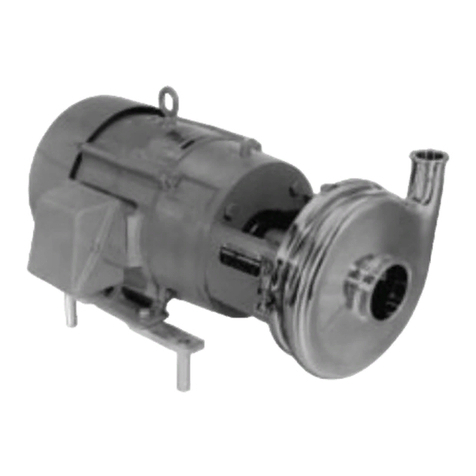
Tri-Clover
Tri-Clover C-Series Service & installation manual

vacuubrand
vacuubrand ME 16C NT VARIO o.C. Instructions for use
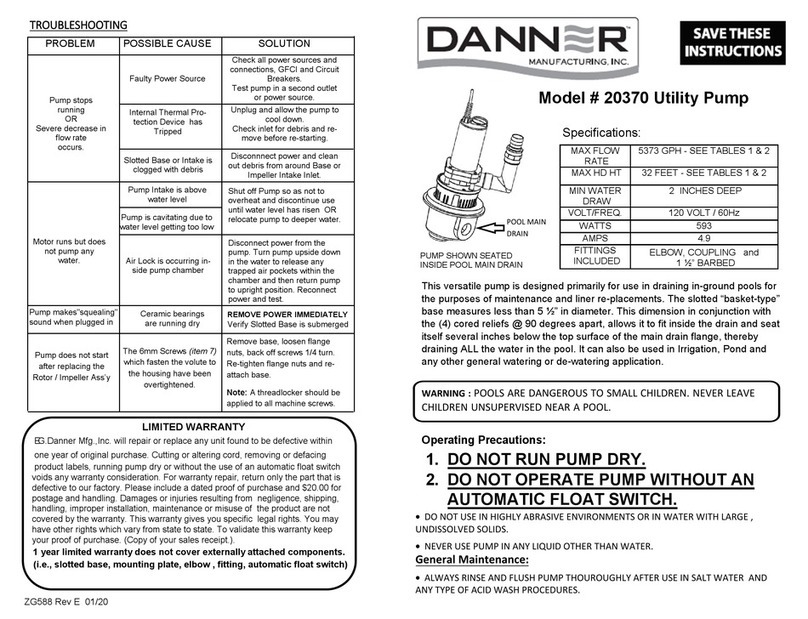
Danner
Danner 20370 quick start guide
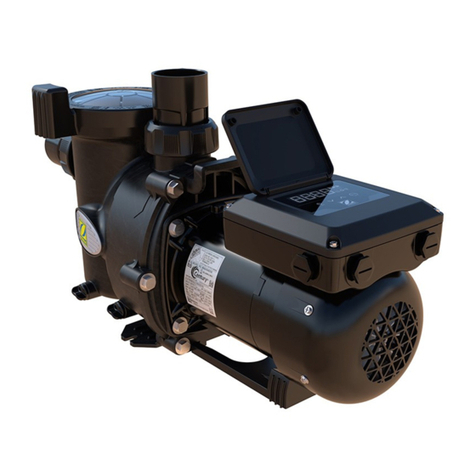
Zodiac
Zodiac E30 iQ Installation and maintenance manual

Samoa
Samoa 108000 Parts and technical service guide

Debem
Debem MB Instructions for use and maintenance
